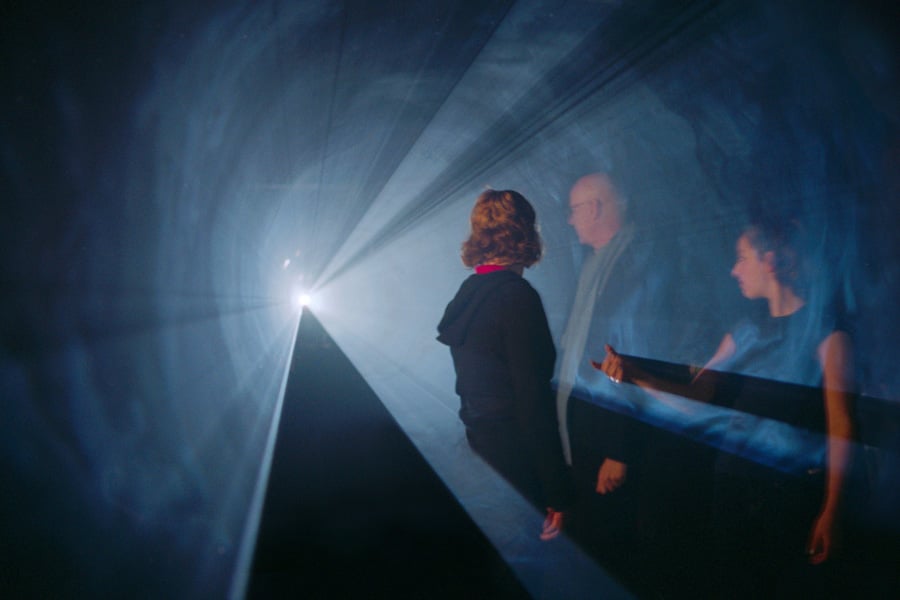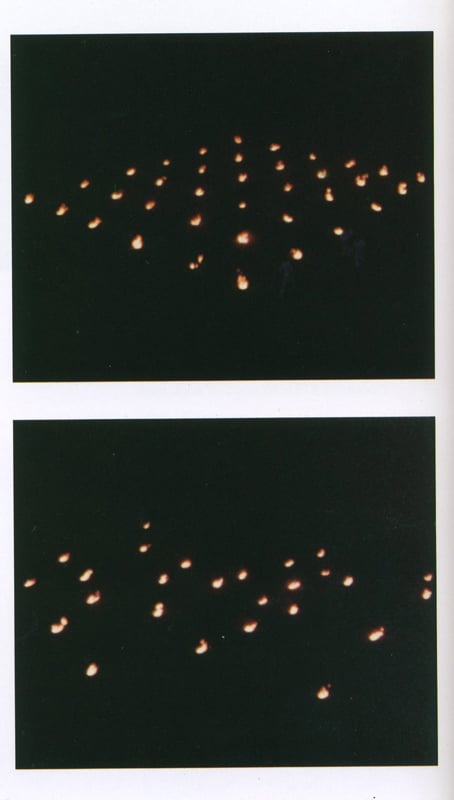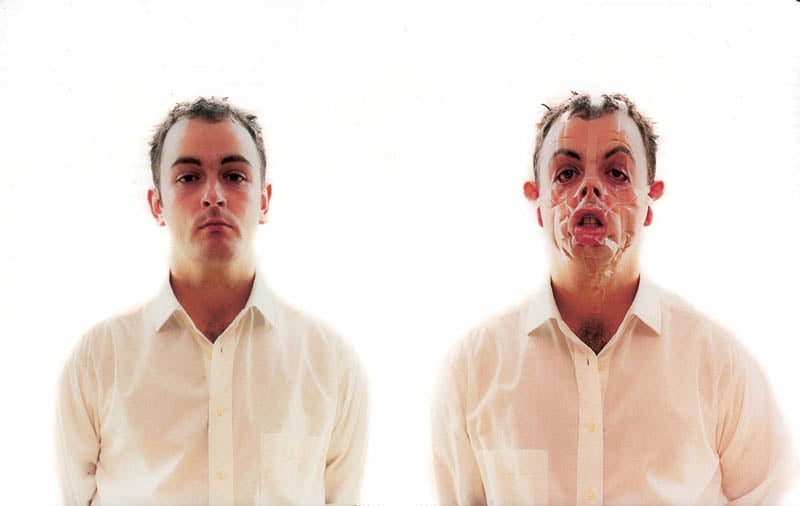
© » KADIST
Anthony McCall
The film Line Describing a Cone was made in 1973 and it was projected for the first time at Fylkingen (Stockholm) on 30 August of the same year. This piece, which was initially screened in independent film contexts, it soon began to be shown at art museums and ended up becoming one of the key works of the artistic movement that opened up the visual arts towards cinema. With a duration of 30 minutes, the film shows the creation of a white curve being projected onto an empty space.

© » KADIST
Anthony McCall
Landscape for fire is a major work by Anthony McCall. The film recounts a performance where characters in white, light up fires in a very orchestrated choreography of lights in a vast flat landscape. The performance is carefully planned – the fires are lit and geometrically aligned in a precise temporal progression.

© » KADIST
Anthony McCall
Drawing & Print (Drawing & Print)
This score is a graphic record of the detailed choreography of one of Anthony McCall’s Landscape for Fire performances. These took place between 1972-74 in the UK at the Museum of Modern Art in Oxford, Colchester School of Art, in Reading and in North Weald as well as in Sweden at Fylkingen Society of Contemporary Music and Arts, Stockholm, and in the USA at the William Patterson University, Wayne, New Jersey. Many of these events were photographed by David Kilburn and Carolee Schneemann, only one in 1972 was filmed.

© » KADIST
Doug Aitken
The version of Frontier acquired by the Kadist Collection consists of a single-channel video, adapted from the monumental installation and performance that Aitken presented in Rome, by the Tiber River, in 2009. In this film, Aiken’s allusion to “the frontier” and iconic imagery like the cowboy suggest that the American West Coast as a cultural construction. These notions are reinforced by two key elements in the film: its protagonist, the iconic West Coast artist Ed Ruscha, and its reference to the cinematic and the experience of the movie theater.

© » KADIST
Diana Thater
In Perpetual Motion (2005) the seemingly erratic flight of the bright orange Monarch butterfly—filmed in its winter habitat of Michoacán, Mexico—is intensified by the artist’s editing in which frames are randomly dropped and the film is sped up. As a result, the butterflies become hyper-real and animated in appearance. The manipulated footage is presented in a video wall of nine monitors, where the butterflies flit from screen to screen, in a room bathed in vivid orange light.

© » KADIST
Douglas Gordon
Blind Spencer is part of the series “Blind Stars” including hundreds of works in which the artist cut out the eyes of Hollywood stars, in a symbolically violent manner. An emptiness (some are burned letting appear a white or mirror background or a mirror) replaces the eyes, giving the impression of a blind eye deprived of all expression. Paradoxically, the work looks at us all the more intensely.

© » KADIST
Tony Oursler
Continuing Oursler’s broader exploration of the moving image, Absentia is one of three micro-scale installations that incorporate small objects and tiny video projections within a miniature active proscenium. Mounted on platforms suspended in space on metal stands, the video sculpture contemplates human relationships, expressed here by shouts and murmurs, the strange and the familiar.

© » KADIST
Douglas Gordon
Douglas Gordon’s single-channel video The Left Hand Can’t See That The Right Hand is Blind, captures an unfolding scene between two hands in leather gloves—at first seemingly comfortable to be entwined, and later, engaged in a struggle. As suggested by the work’s title, each of the hands assumes a character with a distinct personality, as if we were witnessing a lovers’ quarrel and embrace, or the embodiment of opposing forces of an internal struggle. Gordon has previously created performance-based works depicting his own body or parts of it—arms, hands, fingers, eyes—usually enacting simple, repetitive movements.

© » KADIST
Mike Kelley
Towhead n’Ganga, enclosed in darkness, lorded over by the sexualized folded high priestless form reflects many of Kelley’s works, in both its compositional and semantic qualities. The drawing on wood, the popcorn mixture, and the title all manifest a bumpy fullness, a “more-is-more” conflation between supposedly eternal spirituality and everyday stuff. The work’s title points to a serious timelessness completely belied by the materials.

© » KADIST
Douglas Gordon
In Monster (1996-97), the artist’s face becomes grotesque through the application of strips of transparent adhesive tape, typical of Gordon’s performance-based films that often depict his own body in action. Also characteristic of his work, the scene takes place in front of a mirror, suggesting the kind of personal self-reflection that one is capable of – both good and evil. The video makes clear cinematographic reference to the ‘alter-ego’ transformation in Mamoulian’s Dr. Jekyll and Mr. Hyde, and to the “You looking at me?” sequence performed in front of a mirror by Robert De Niro in Scorsese’s Taxi Driver which also inspired Gordon’s through a looking glass ( 1999).
Anthony McCall
- location: London, United Kingdom
- year born: 1946
- gender: male
- nationality: British
Douglas Gordon
- location: Berlin, Germany
- year born: 1966
- gender: male
- nationality: Scottish
- home town: Glasgow, United Kingdom
Doug Aitken
- year born: 1968
- gender: male
- nationality: American
- home town: Redondo Beach, California
Mike Kelley
- location: Los Angeles, California
- year born: 1954
- gender: male
- nationality: American
- home town: Detroit, Michigan
Tony Oursler
- year born: 1957
- gender: male
- nationality: American
- home town: New York, New York
Diana Thater
A pioneer of video and film installations for over a decade, Diana Thater’s works explore the nature and possibilities of moving-image media...
-
1970-1979
Anthony McCall
1973The film Line Describing a Cone was made in 1973 and it was projected for the first time at Fylkingen (Stockholm) on 30 August of the same year...
Anthony McCall
Drawing & Print
1974(Drawing & Print) This score is a graphic record of the detailed choreography of one of Anthony McCall’s Landscape for Fire performances...
-
1990-1999
Mike Kelley
1996Towhead n’Ganga, enclosed in darkness, lorded over by the sexualized folded high priestless form reflects many of Kelley’s works, in both its compositional and semantic qualities...
Douglas Gordon
1996In Monster (1996-97), the artist’s face becomes grotesque through the application of strips of transparent adhesive tape, typical of Gordon’s performance-based films that often depict his own body in action...
-
2000-2009
Douglas Gordon
2002Blind Spencer is part of the series “Blind Stars” including hundreds of works in which the artist cut out the eyes of Hollywood stars, in a symbolically violent manner...
Douglas Gordon
2004Douglas Gordon’s single-channel video The Left Hand Can’t See That The Right Hand is Blind, captures an unfolding scene between two hands in leather gloves—at first seemingly comfortable to be entwined, and later, engaged in a struggle...
Diana Thater
2005In Perpetual Motion (2005) the seemingly erratic flight of the bright orange Monarch butterfly—filmed in its winter habitat of Michoacán, Mexico—is intensified by the artist’s editing in which frames are randomly dropped and the film is sped up...
Doug Aitken
2009The version of Frontier acquired by the Kadist Collection consists of a single-channel video, adapted from the monumental installation and performance that Aitken presented in Rome, by the Tiber River, in 2009...
-
2010-2019
Tony Oursler
2012Continuing Oursler’s broader exploration of the moving image, Absentia is one of three micro-scale installations that incorporate small objects and tiny video projections within a miniature active proscenium...